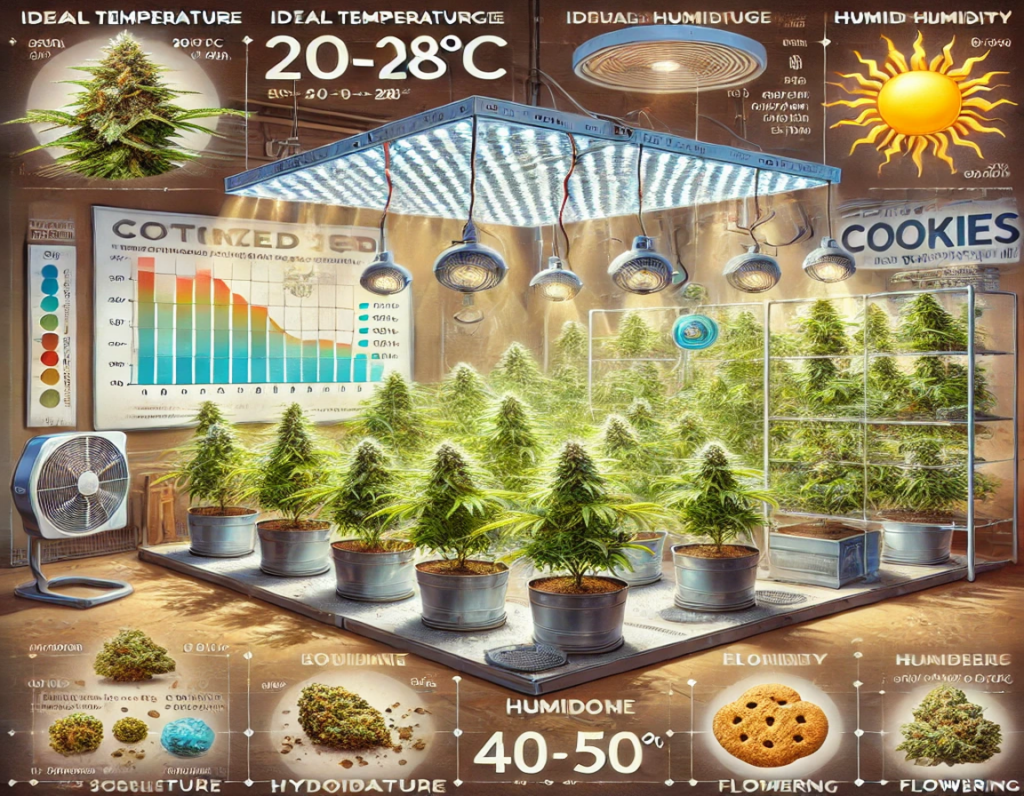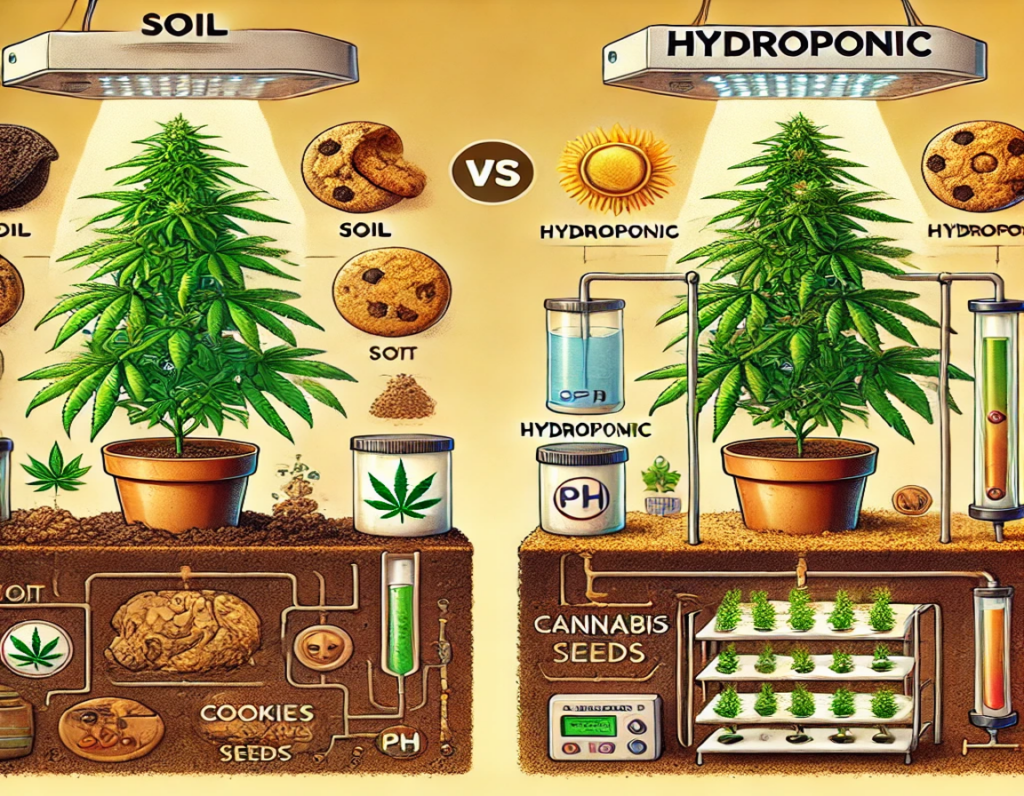
Canada’s diverse climate means that choosing the right Cookies seed variety is crucial to ensure a successful harvest. From autoflowering strains that thrive in shorter growing seasons to cold-resistant varieties that can handle lower temperatures, selecting the right strain is the first step in elevating your Cookies Seeds cultivation.
For growers in milder regions like British Columbia or Southern Ontario, outdoor cultivation is feasible with longer flowering Cookies strains, such as Girl Scout Cookies or Cookies Kush, which can benefit from the warmer temperatures and extended daylight hours during the summer. On the other hand, growers in colder regions like Alberta or Manitoba may want to opt for autoflowering strains such as Auto Cookies or Fast Flowering Cookies, which have a shorter lifecycle and can be harvested before the first frost hits.
Real-time data on cannabis seed sales in Canada indicates a growing preference for strains that offer higher yields and shorter flowering times, especially in regions where outdoor growing seasons are limited. Autoflowering Cookies strains have become a popular choice in areas with unpredictable weather patterns, as they flower automatically based on age rather than light cycles, making them a reliable option for Canadian growers.

Whether you’re growing indoors or outdoors, creating the right environment for your Cookies Seeds is essential to achieve healthy growth and maximize your yields. For indoor growers, controlling factors like temperature, humidity, and light exposure is critical to creating the ideal conditions for cannabis plants.
Cookies Seeds thrive in temperatures between 20-28°C (68-82°F). If you’re growing outdoors in regions with colder climates, using greenhouses or grow tents can help maintain consistent temperatures. Indoor growers can use heaters, fans, and air conditioners to regulate the environment.
During the vegetative stage, aim for 60-70% humidity, and reduce it to 40-50% during flowering to prevent mold and mildew. This is particularly important in coastal areas like British Columbia, where humidity levels tend to be higher.
Indoors, full-spectrum LED grow lights are ideal for providing the right amount of light for each growth stage. During the vegetative phase, plants need around 18-20 hours of light per day, which should be reduced to 12 hours during the flowering phase to encourage bud development.
For outdoor growers, ensuring that your plants receive ample sunlight (at least 6-8 hours per day) is crucial, particularly in northern regions where daylight hours are shorter. Setting up your grow site to maximize sunlight exposure can make a significant difference in the growth and yield of your Cookies Seeds.

One of the biggest decisions you’ll face as a grower is whether to use a traditional soil-based setup or explore hydroponic systems. Each method has its advantages, and the best option depends on your goals, budget, and available space.
Growing Cookies Seeds in soil is a more forgiving method, particularly for beginners. Soil offers a natural buffer that helps regulate nutrients and pH levels, making it easier to avoid nutrient burn or deficiencies. It’s also a more affordable setup, as soil is readily available and requires minimal additional equipment. However, soil growing can take up more space and may result in slower plant growth compared to hydroponics.
Hydroponic systems, which involve growing plants in nutrient-rich water rather than soil, are becoming increasingly popular in Canada, especially among indoor growers. Hydroponics allows for faster growth rates and higher yields because nutrients are delivered directly to the plant roots. This method is ideal for maximizing space in small indoor setups. However, it requires careful monitoring of water quality, pH levels, and nutrient solutions to avoid common issues like root rot or nutrient deficiencies.
For Canadian growers looking to increase efficiency and maximize yields, hydroponic systems offer a great advantage, particularly in areas with limited outdoor growing seasons. The upfront investment may be higher than soil-based setups, but the long-term benefits often outweigh the costs, especially for experienced growers.

Proper nutrient management is crucial to achieving robust growth and maximizing your Cookies Seeds’ yield. The specific nutrient requirements of cannabis plants vary depending on their growth stage, so it’s important to adjust your feeding schedule accordingly.
During the early stages, cannabis plants require minimal nutrients. Start with a diluted solution of nitrogen-rich nutrients, and gradually increase the strength as your plants grow.
In this stage, Cookies Seeds require a nutrient mix rich in nitrogen (N), phosphorus (P), and potassium (K). Maintaining a balanced NPK ratio will promote healthy foliage and root development. Be cautious not to overfeed, as nutrient burn can stunt plant growth.
Once your plants enter the flowering stage, their nutrient needs shift. Reduce nitrogen levels and increase phosphorus and potassium to support bud development. Using bloom-specific nutrients will help your Cookies Seeds produce large, dense buds.
Water quality is another critical factor in cannabis cultivation, especially in Canada, where water hardness can vary significantly by region. In areas with hard water, consider using a water filtration system to avoid mineral buildup that can affect nutrient uptake. Additionally, ensure you’re maintaining the proper pH levels in your nutrient solution (between 5.5 and 6.5 for hydroponic systems and 6.0 to 7.0 for soil grows) to optimize nutrient absorption.

Growing Cookies Seeds in Canada comes with its own set of challenges, particularly when it comes to pests and environmental factors. Whether you’re growing indoors or outdoors, it’s essential to take proactive steps to prevent infestations and other issues.
Spider mites, aphids, and whiteflies are common pests that can damage cannabis plants. In outdoor grows, it’s important to monitor your plants regularly for signs of infestation. Natural pest control methods, such as introducing beneficial insects like ladybugs or using organic insecticides, are effective ways to keep your grow area pest-free.
Humid conditions, particularly in coastal regions, can lead to mold and mildew problems during the flowering stage. Ensure your grow space has good ventilation and reduce humidity levels to minimize the risk of mold. Outdoors, keeping your plants well-spaced and pruning them for airflow can help prevent mold growth.
Canadian growers, particularly those in the northern regions, often face challenges with cold weather. Frost can severely damage your plants, so it’s important to monitor nighttime temperatures closely. Using frost covers or bringing plants indoors during cold snaps can protect your crop from sudden temperature drops.
By staying vigilant and addressing these challenges early, you can ensure your Cookies Seeds grow healthy and produce high-quality buds.
Autoflowering strains like Auto Cookies or Fast Flowering Cookies are ideal for shorter growing seasons in colder regions.
It depends on your region. Outdoor growing is ideal in warmer provinces with longer summers, while indoor growing offers better control in colder climates.
Drip systems and Deep Water Culture (DWC) are excellent choices for small indoor spaces, offering efficient water and nutrient management.
Regular monitoring and the use of organic pest control methods, such as beneficial insects or organic sprays, are effective in preventing infestations.
Watering frequency depends on the growth stage and environment. Ensure water pH levels are balanced and use filtered water if necessary to prevent mineral buildup.
We ship and deliver world wide via USPS and various couriers.
We offer a wide range of secure and anonymous online payment options.
We care about you, our customer. Please contact us with any questions or concerns.
Find out more about the benefits of being a loyal and regular customer.
WE ARE EVERY GROWERS ONE STOP SHOP TO ACQUIRE PREMIUM CANNABIS SEEDS FOR SALE IN THE USA, CANADA AND AUSTRALIA

Farmers Lab Seeds 2024, | All Right Reserved
Seeds are sold as novelty items, souvenirs, and collectibles. They contain 0% THC. We encourage our customers to check the legislation in their Country, State, Province, and Municipality prior to purchasing items from our store. We do not provide growing information.
All seeds are sold as hemp, and lab tested under 0.3% THC. This product is not for use by or sale to persons under the age of 21. This product should be used only as directed on the label. It should not be used if you are pregnant or nursing. Consult with a physician before use if you have a serious medical condition or use prescription medications. A Doctor’s advice should be sought before using this and any supplemental dietary product. All trademarks and copyrights are property of their respective owners and are not affiliated with nor do they endorse this product.
These statements have not been evaluated by the FDA. This product is not intended to diagnose, treat, cure or prevent any disease. Individual weight loss results will vary. By using this site, you agree to follow the Privacy Policy and all Terms & Conditions printed on this site. Void Where Prohibited by Law.